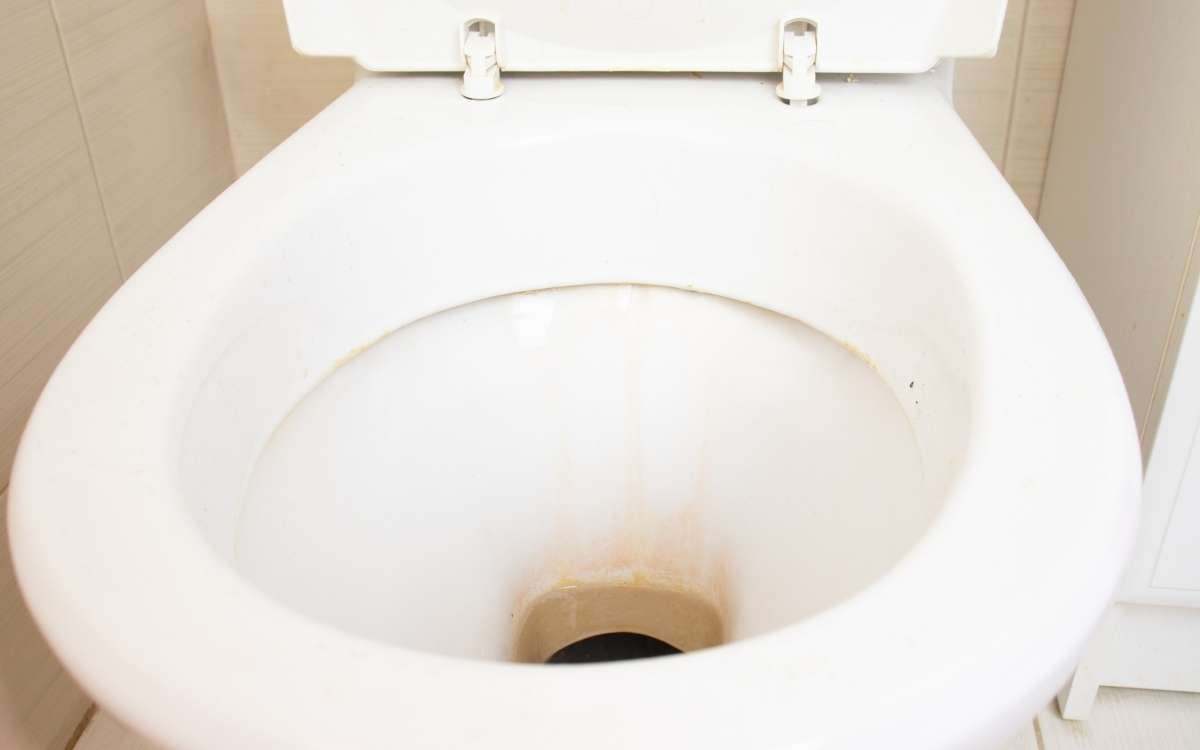

FAQs
Why Does My Discharge Bleach Underwear
Modified: August 28, 2023
Looking for answers to general questions about why your discharge may bleach your underwear? Find out the causes and possible solutions in this informative guide.
(Many of the links in this article redirect to a specific reviewed product. Your purchase of these products through affiliate links helps to generate commission for Under-tec.com, at no extra cost. Learn more)
Table of Contents
Introduction
Dealing with vaginal discharge can be a normal part of a woman’s life. However, it can sometimes come with unexpected side effects like bleaching underwear. While it may not be a topic many people openly discuss, it’s important to understand why this happens and what it could potentially mean for your health.
Vaginal discharge is a natural and healthy occurrence that helps to keep the vaginal area clean and lubricated. Its consistency and color can vary depending on factors such as menstrual cycle, sexual activity, and overall vaginal health. However, when discharge starts to bleach or discolor underwear, it can be a cause for concern or confusion.
In this article, we will delve into the reasons behind why discharge may bleach underwear, the possible causes, and what you can do to prevent it. While it’s essential to remember that each person’s experience may vary, having a better understanding of the phenomenon can help you gauge if it’s a normal occurrence or something worth seeking medical advice for.
Understanding Discharge
Vaginal discharge is a normal bodily function that helps to maintain the health and cleanliness of the vaginal area. It is produced by the cervix and the walls of the vagina and typically consists of a combination of fluids, bacteria, and cells. The consistency, color, and odor of discharge can vary throughout the menstrual cycle, and it is influenced by factors such as hormones, sexual activity, and overall vaginal health.
Normal vaginal discharge is usually clear or white and may have a slight odor. It serves several important purposes, including keeping the vagina moist, preventing infections, and flushing away dead cells and bacteria. The amount and texture of discharge can change throughout the cycle, ranging from thin and watery to thick and gel-like.
It’s important to note that discharge is different for every individual, and what is considered normal for one person may be different for another. However, there are certain signs that may indicate a potential issue with vaginal health. These include a change in odor, color, consistency, or the presence of itching, burning, or discomfort.
If you experience any of these symptoms, it’s advisable to consult with a healthcare professional to determine the cause and receive proper treatment if necessary. Understanding what is normal for your body is key in identifying any changes that may require further attention.
Vaginal discharge can be affected by various factors, such as hormonal changes during the menstrual cycle. For example, during ovulation, discharge may become thinner and clearer, resembling the consistency of egg whites, which can indicate that you are at your most fertile. On the other hand, after menstruation, discharge may appear thicker and white or yellowish in color.
Furthermore, sexual arousal can also increase the production of vaginal discharge. This is a natural response to prepare the vagina for sexual activity, providing lubrication and reducing friction. However, if the discharge is accompanied by itching, a foul odor, or discomfort, it may indicate an infection or an imbalance in the vaginal microbiota.
It’s important to pay attention to any changes in your discharge and seek medical advice if you notice any significant deviations from what is normal for you. Regularly monitoring and understanding your body’s natural patterns can help maintain optimal vaginal health.
Factors Affecting Discharge Color
The color of vaginal discharge can vary, ranging from clear and white to yellow, green, or even brown. The hue of discharge can provide valuable insight into certain aspects of your vaginal health. Understanding the factors that can influence the color of your discharge can help you differentiate between normal variation and potential concerns.
1. Menstrual cycle: The color of vaginal discharge often changes throughout the menstrual cycle. During the follicular phase (before ovulation), discharge is typically clear and watery. As ovulation approaches, it may become stretchy and resemble raw egg whites. After ovulation, the discharge may become thicker and white or slightly yellowish.
2. Hormonal changes: Hormonal fluctuations can impact the color of your discharge. For example, during pregnancy, discharge may appear milky or white due to increased levels of estrogen. Similarly, hormone changes during menopause can cause the discharge to become thin, dry, and less frequent.
3. Infections or STIs: Certain infections, such as yeast infections or bacterial vaginosis, can cause abnormal discharge. Yeast infections typically produce thick, chunky, white discharge, while bacterial vaginosis often results in grayish, fishy-smelling discharge. Sexually transmitted infections (STIs) like trichomoniasis can cause green or yellow discharge.
4. Medications and contraceptives: Some medications, including antibiotics, can alter the color of your discharge. Additionally, hormonal contraceptives like birth control pills or intrauterine devices (IUDs) can cause changes in discharge consistency and color.
5. Sexual activity: Engaging in sexual activity can lead to changes in vaginal discharge. Increased blood flow and arousal can cause the discharge to appear pink or have a slight tinge of blood.
6. Hygiene products: The use of scented soaps, douches, or vaginal sprays can disrupt the natural pH balance of the vagina, leading to changes in discharge color and odor.
It’s important to note that while some variations in discharge color are normal, others may indicate an underlying issue. If you notice any significant changes in color, consistency, odor, or experience other accompanying symptoms such as itching, burning, or discomfort, it’s advisable to consult with a healthcare professional for further evaluation and appropriate treatment.
Regularly monitoring your discharge and understanding what is normal for your body can help you identify any abnormal changes and seek timely medical attention if needed.
Why Does Discharge Bleach Underwear?
Discovering that your underwear has been bleached by vaginal discharge can be quite perplexing. However, there are a few reasons why this phenomenon occurs.
One of the main reasons why discharge may bleach underwear is due to its acidic or alkaline nature. Vaginal discharge has a slightly acidic pH level, which helps to maintain a healthy balance of bacteria and prevent the overgrowth of harmful microorganisms. Sometimes, this acidic discharge can react with the dyes or fabrics in underwear, causing them to discolor or bleach.
In addition to pH levels, discharge may contain enzymes or chemicals that can contribute to the bleaching effect. These substances could react with the fibers in the underwear, resulting in color loss or fading.
Another factor that can contribute to discharge bleaching underwear is the presence of small traces of bleach or other cleaning agents on the underwear. Sometimes, residues from laundry detergents or bleach used during the washing process may remain on the fabric. When combined with discharge, these residues can cause a bleaching effect.
It’s important to note that the bleaching of underwear by vaginal discharge is usually harmless and does not necessarily indicate a health concern. However, if you notice any significant changes in the color or consistency of your discharge, or if you experience other accompanying symptoms such as itching, odor, or discomfort, it’s advisable to consult with a healthcare professional for further evaluation.
It’s worth mentioning that while discharge may bleach underwear, it is crucial to maintain proper hygiene practices to minimize any potential issues. Make sure to wash your underwear with gentle, unscented detergents and avoid using bleach or harsh cleaning agents that can further exacerbate the bleaching effect.
If you find that the bleaching of your underwear is causing distress or discomfort, you may want to consider wearing a panty liner or changing your underwear more frequently throughout the day. This can help reduce the amount of time that discharge comes into contact with your underwear, potentially minimizing the bleaching effect.
Lastly, replacing and rotating your underwear regularly can also help prevent excessive discoloration. If you notice that certain pairs of underwear are consistently being bleached, it might be time to invest in new ones made from different materials or with better colorfastness.
In summary, the bleaching of underwear by vaginal discharge is typically a benign occurrence and is often caused by the acidic nature or chemical composition of discharge. By maintaining good hygiene practices and being mindful of the fabrics and cleaning agents used, you can minimize the bleaching effect and ensure optimal vaginal health.
Possible Causes of Bleaching
While the bleaching of underwear by vaginal discharge is generally considered a normal occurrence, it’s essential to explore potential causes that may contribute to this phenomenon. Understanding these causes can help you determine whether there is an underlying issue that needs to be addressed.
1. pH Imbalance: One possible cause of bleaching is a pH imbalance in the vaginal environment. The natural pH of the vagina is slightly acidic, which helps maintain a healthy balance of bacteria. If there is an imbalance in this acidity, it can lead to changes in discharge composition, including chemicals that could contribute to the bleaching effect.
2. Infections or Irritations: Certain infections, such as yeast infections or bacterial vaginosis, can cause changes in discharge composition and increase its acidic nature. This can potentially contribute to bleaching. Additionally, irritations caused by harsh soaps, detergents, or personal care products can also irritate the vaginal area and potentially alter the discharge, leading to bleaching.
3. Medications: Some medications, including antibiotics or antifungals, can alter the composition and pH of vaginal discharge. These changes may affect the bleaching potential of discharge, especially when combined with factors such as sweat or urine.
4. Diet and Hydration: Diet and hydration can indirectly impact the acidity of vaginal discharge. Lack of hydration or consumption of certain foods, such as those high in sugar or processed ingredients, can create an environment that promotes the growth of harmful bacteria or disrupts the natural pH balance. This, in turn, may affect the composition of discharge and its bleaching potential.
5. Sweat and Urine: Sweat and urine can provide additional factors that contribute to the bleaching of underwear. When combined with discharge, the chemical composition of sweat and urine can react with the fabrics or dyes in underwear, causing discoloration or bleaching.
It’s important to remember that some degree of bleaching is considered normal. However, if you notice significant changes in the color or consistency of your discharge, such as a foul odor, itching, burning, or discomfort, it’s advisable to consult with a healthcare professional. They can evaluate your symptoms, determine the underlying cause, and provide appropriate treatment if necessary.
To minimize the potential causes of bleaching, it’s recommended to practice good hygiene habits. This includes using mild, unscented soaps, avoiding harsh detergents or fabric softeners, and wearing breathable underwear made from natural materials. Additionally, staying hydrated, maintaining a healthy diet, and being mindful of any potential irritants in your environment can help promote vaginal health and reduce the likelihood of bleaching.
By understanding the potential causes of bleaching, you can better manage and address any concerns related to the discoloration of your underwear.
Remedies and Prevention
While the bleaching of underwear by vaginal discharge is usually harmless, there are several remedies and preventive measures you can take to manage and minimize this occurrence.
1. Maintain Good Hygiene: Proper hygiene practices are essential for maintaining vaginal health. Wash your genital area with mild, unscented soap and water daily. Avoid using harsh cleansers or douches, as these can disrupt the natural pH balance and increase the likelihood of bleach-like discoloration.
2. Choose Underwear Wisely: Opt for underwear made from breathable, natural fabrics like cotton or bamboo. These materials allow for better air circulation, reducing moisture buildup and minimizing the potential for bleaching. Avoid synthetic materials that can trap moisture and create a breeding ground for bacteria.
3. Change Underwear Frequently: It’s important to change your underwear regularly, especially if you notice excessive discharge. This helps to reduce the amount of time that discharge comes into contact with the fabric, potentially minimizing the bleaching effect.
4. Panty Liners: Wearing panty liners can provide an extra layer of protection for your underwear. They can absorb excess discharge and reduce direct contact between discharge and the fabric, which can help prevent bleaching.
5. Avoid Harsh Chemicals: Be cautious of using harsh detergents, fabric softeners, or bleach when washing your underwear. These chemicals can react with the discharge and fabric, potentially causing discoloration or bleaching. Opt for mild, fragrance-free detergents designed for sensitive skin.
6. Take note of non-vaginal sources: Remember that not all bleaching is caused by vaginal discharge. Other potential sources of discoloration can include sweat, urine, or, in rare cases, vaginal infections. Therefore, it’s important to consider these factors when troubleshooting the cause of bleaching.
7. Maintain a Balanced Diet and Hydration: A healthy diet and proper hydration can contribute to overall vaginal health. Avoid excessive sugar consumption and maintain a balanced diet rich in fruits, vegetables, whole grains, and lean proteins. Drinking an adequate amount of water can help flush toxins from the body and maintain proper moisture balance.
If you experience persistent bleaching of underwear or notice any changes in the color or consistency of your discharge, it is advisable to consult with a healthcare professional. They can evaluate your symptoms, provide guidance specific to your situation, and determine if any underlying issues require treatment.
By implementing these remedies and preventive measures, you can manage and minimize the bleaching of underwear caused by vaginal discharge, promoting better hygiene and vaginal health overall.
When to Seek Medical Advice
While the bleaching of underwear by vaginal discharge is usually a normal occurrence, there are certain situations where it’s advisable to seek medical advice. Understanding when to consult with a healthcare professional can help you address any underlying issues and ensure optimal vaginal health.
1. Persistent Change in Discharge: If you notice a persistent change in the color, consistency, odor, or amount of your discharge, it’s essential to seek medical advice. This includes significant changes in the bleaching effect on your underwear or if the discharge becomes frothy, clumpy, or accompanied by itching, burning, or discomfort.
2. Presence of Other Symptoms: If you experience additional symptoms along with the bleaching of your underwear, such as abdominal pain, pelvic pain, fever, or pain during sexual intercourse, it’s important to consult with a healthcare professional. These symptoms may indicate an underlying infection or an issue that requires medical attention.
3. Recurring Infections: If you frequently experience vaginal infections or have a history of recurrent infections, it’s advisable to seek medical advice. Recurrent infections could indicate an underlying condition or an imbalance in your vaginal microbiota that requires proper diagnosis and treatment.
4. Concerns about Vaginal Health: If you have concerns about your overall vaginal health, it’s worth seeking medical advice. This is particularly important if you have a compromised immune system, are pregnant, or if you suspect you may have been exposed to a sexually transmitted infection (STI).
5. Unusual Bleeding or Spotting: If you notice unusual bleeding or spotting unrelated to your menstrual cycle, it’s important to consult with a healthcare professional. While it may not be directly related to the bleaching of underwear, it could indicate an underlying issue that needs to be addressed.
Remember, your healthcare provider is the best resource for assessing your individual situation and providing appropriate guidance. They can evaluate your symptoms, perform necessary tests, and offer personalized recommendations specific to your vaginal health needs.
By seeking medical advice when necessary, you can ensure any potential underlying issues are identified and managed promptly, promoting better overall vaginal health and well-being.
Conclusion
Experiencing the bleaching of underwear by vaginal discharge can be a perplexing and sometimes concerning situation. However, understanding the reasons behind this phenomenon can help put your mind at ease and guide you towards appropriate actions.
Vaginal discharge is a normal and healthy bodily function that helps maintain vaginal health. While discharge bleaching underwear can be attributed to the acidic or alkaline nature of the discharge, it is generally considered a harmless occurrence. Factors such as pH imbalance, certain infections, medications, and even the presence of residues from laundry detergents can contribute to the bleaching effect.
By practicing good hygiene habits, choosing breathable underwear made from natural fabrics, and avoiding harsh chemicals, you can minimize the likelihood and impact of bleaching. Additionally, being mindful of any changes in discharge color or consistency and seeking medical advice when necessary can help address potential underlying issues.
It’s important to remember that each person’s experience with vaginal discharge may vary, and what is considered normal can differ from one individual to another. Regular monitoring, understanding your body’s natural patterns, and seeking medical advice when needed are crucial for maintaining optimal vaginal health.
If you have concerns about the bleaching of your underwear or notice any significant changes in your discharge along with other symptoms, it is always advisable to consult with a healthcare professional. They can provide personalized guidance, perform necessary tests, and offer appropriate treatment if needed.
Ultimately, understanding why discharge may bleach underwear and taking proactive steps to promote vaginal health can help you feel more confident and comfortable in managing this common occurrence. By maintaining good hygiene practices, seeking medical advice when necessary, and being attuned to your body’s signals, you can ensure your overall vaginal well-being.










